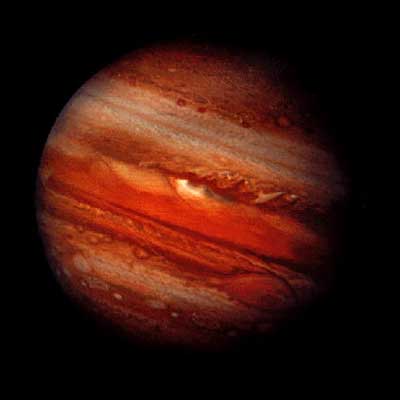Jupiter
 Compared
to the relative closeness of the first four planets, out to the orbit of
Jupiter is quite a jump. Jupiter holds the record for the largest
planet in the solar system, but its size is not supported by its mass.
It's called a "gas giant", being made up of gaseous material that makes
it have the lowest mass for its volume of all the planets Jupiter
is more than 10 Earth diameters across, but is only one-quarter the density
of Earth. Jupiter has a large spot on its surface, a constant hurricane
that changes in size from time to time. It's a "flattened" planet,
being larger in size at the equator than in other directions, because of
the rotation flowing the gases out at that point. Jupiter has four
moons, and has been photographed by several Voyager missions.
Compared
to the relative closeness of the first four planets, out to the orbit of
Jupiter is quite a jump. Jupiter holds the record for the largest
planet in the solar system, but its size is not supported by its mass.
It's called a "gas giant", being made up of gaseous material that makes
it have the lowest mass for its volume of all the planets Jupiter
is more than 10 Earth diameters across, but is only one-quarter the density
of Earth. Jupiter has a large spot on its surface, a constant hurricane
that changes in size from time to time. It's a "flattened" planet,
being larger in size at the equator than in other directions, because of
the rotation flowing the gases out at that point. Jupiter has four
moons, and has been photographed by several Voyager missions.
|
Planet
|
Size (diameter in km)
|
Distance from Sun - km
|
Distance as ratio of earth
|
Mean surface temperature - Celsius
|
|
Jupiter
|
142,980
|
778,330,000
|
5.2
|
- 153
|
More information on Jupiter:
http://pds.jpl.nasa.gov/planets/choices/jupiter1.htm
http://www.seds.org/nineplanets/nineplanets/jupiter.html
[ Back to Solar
System Page ] [ Rocket on to Saturn]
[ Main Page ]
Page by Francis Perry, April 2002
 Compared
to the relative closeness of the first four planets, out to the orbit of
Jupiter is quite a jump. Jupiter holds the record for the largest
planet in the solar system, but its size is not supported by its mass.
It's called a "gas giant", being made up of gaseous material that makes
it have the lowest mass for its volume of all the planets Jupiter
is more than 10 Earth diameters across, but is only one-quarter the density
of Earth. Jupiter has a large spot on its surface, a constant hurricane
that changes in size from time to time. It's a "flattened" planet,
being larger in size at the equator than in other directions, because of
the rotation flowing the gases out at that point. Jupiter has four
moons, and has been photographed by several Voyager missions.
Compared
to the relative closeness of the first four planets, out to the orbit of
Jupiter is quite a jump. Jupiter holds the record for the largest
planet in the solar system, but its size is not supported by its mass.
It's called a "gas giant", being made up of gaseous material that makes
it have the lowest mass for its volume of all the planets Jupiter
is more than 10 Earth diameters across, but is only one-quarter the density
of Earth. Jupiter has a large spot on its surface, a constant hurricane
that changes in size from time to time. It's a "flattened" planet,
being larger in size at the equator than in other directions, because of
the rotation flowing the gases out at that point. Jupiter has four
moons, and has been photographed by several Voyager missions.